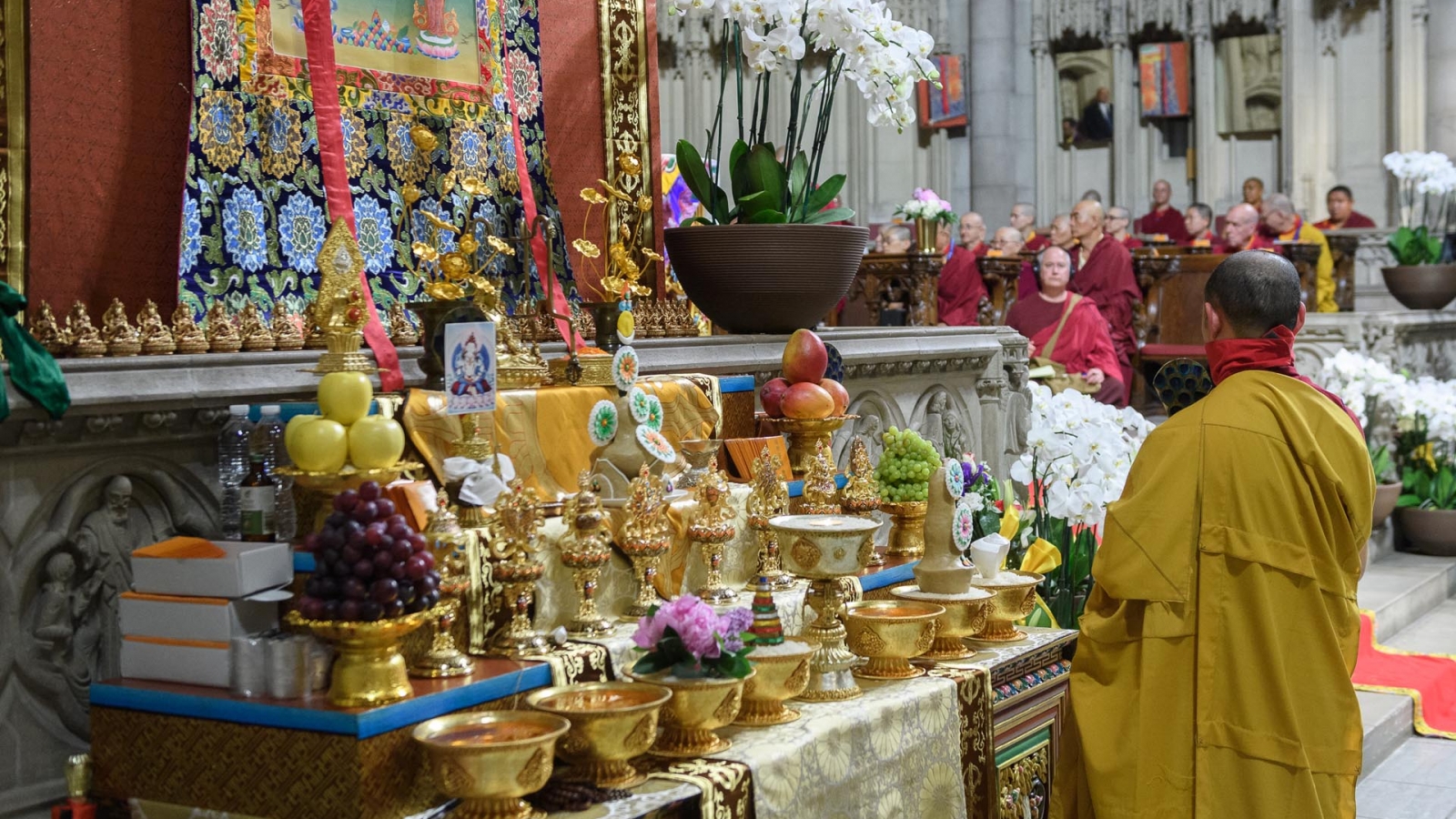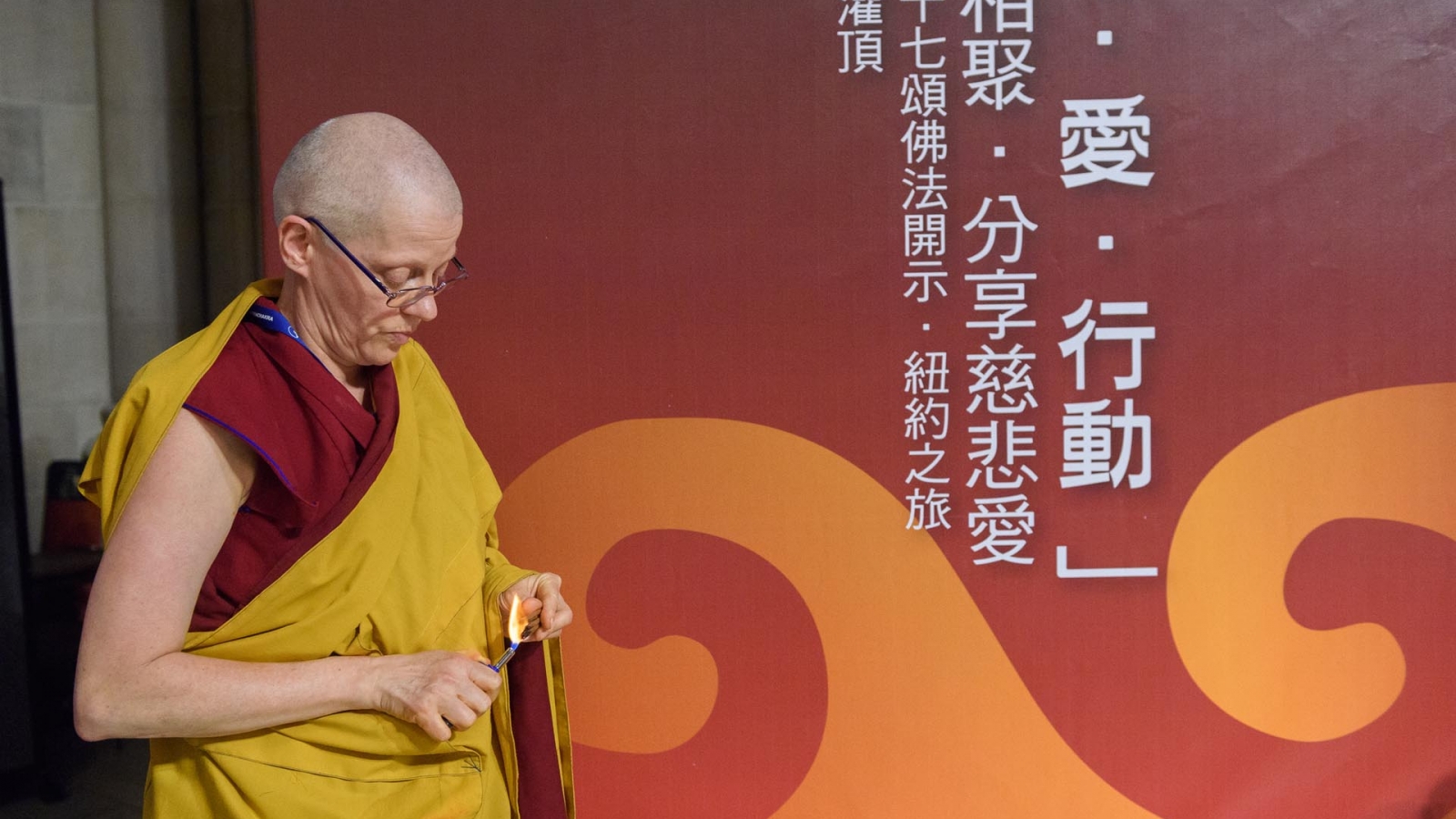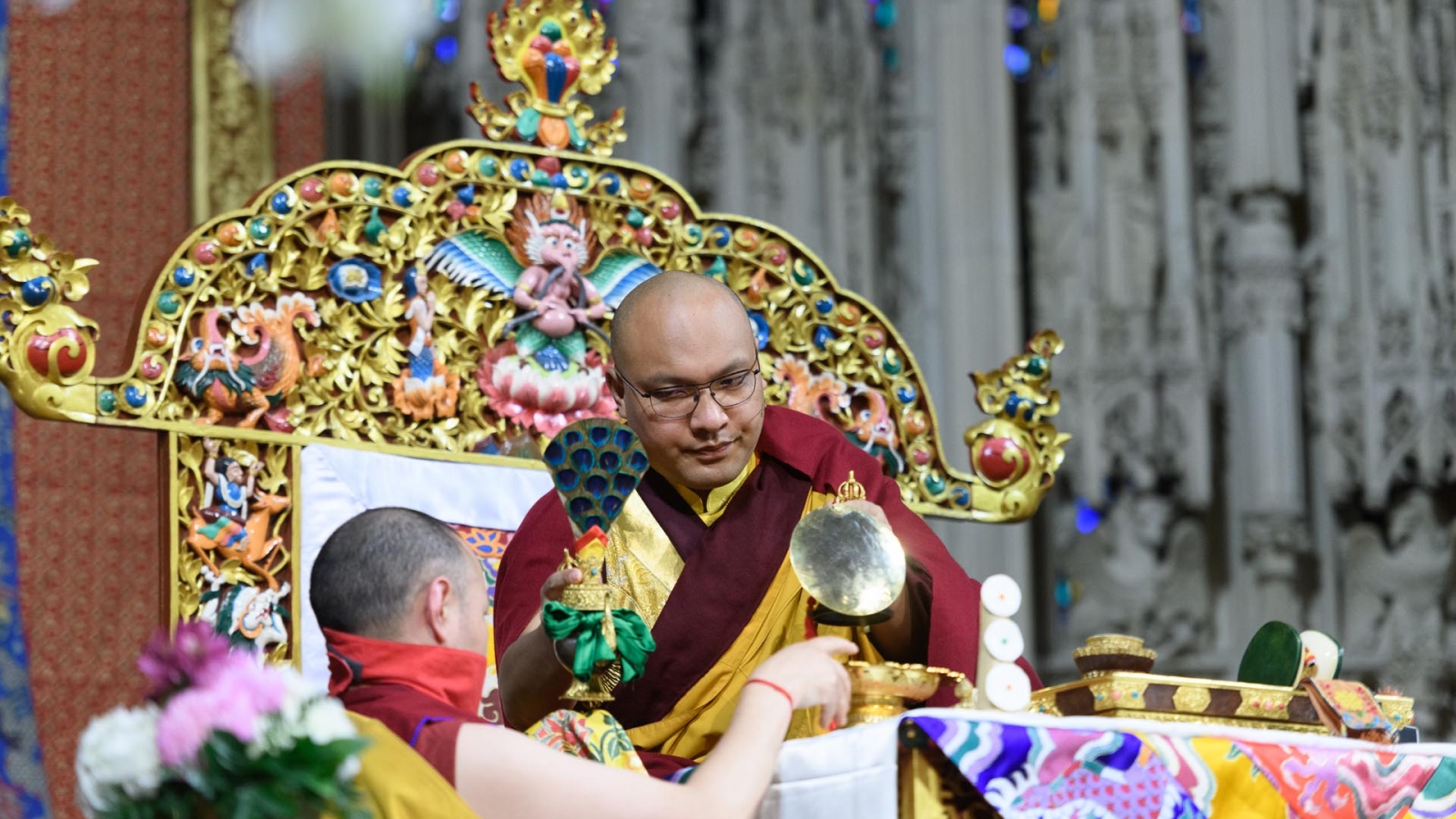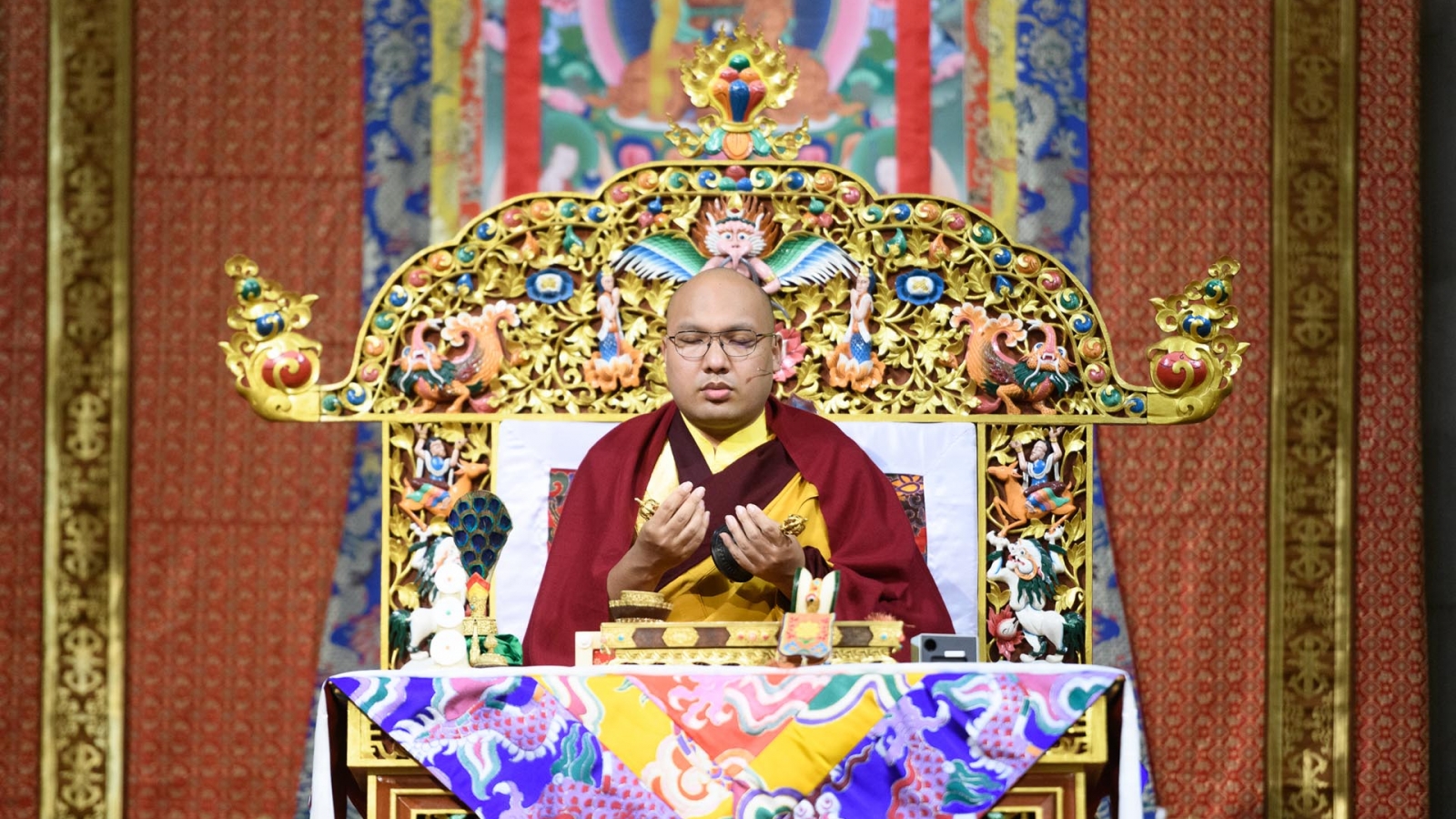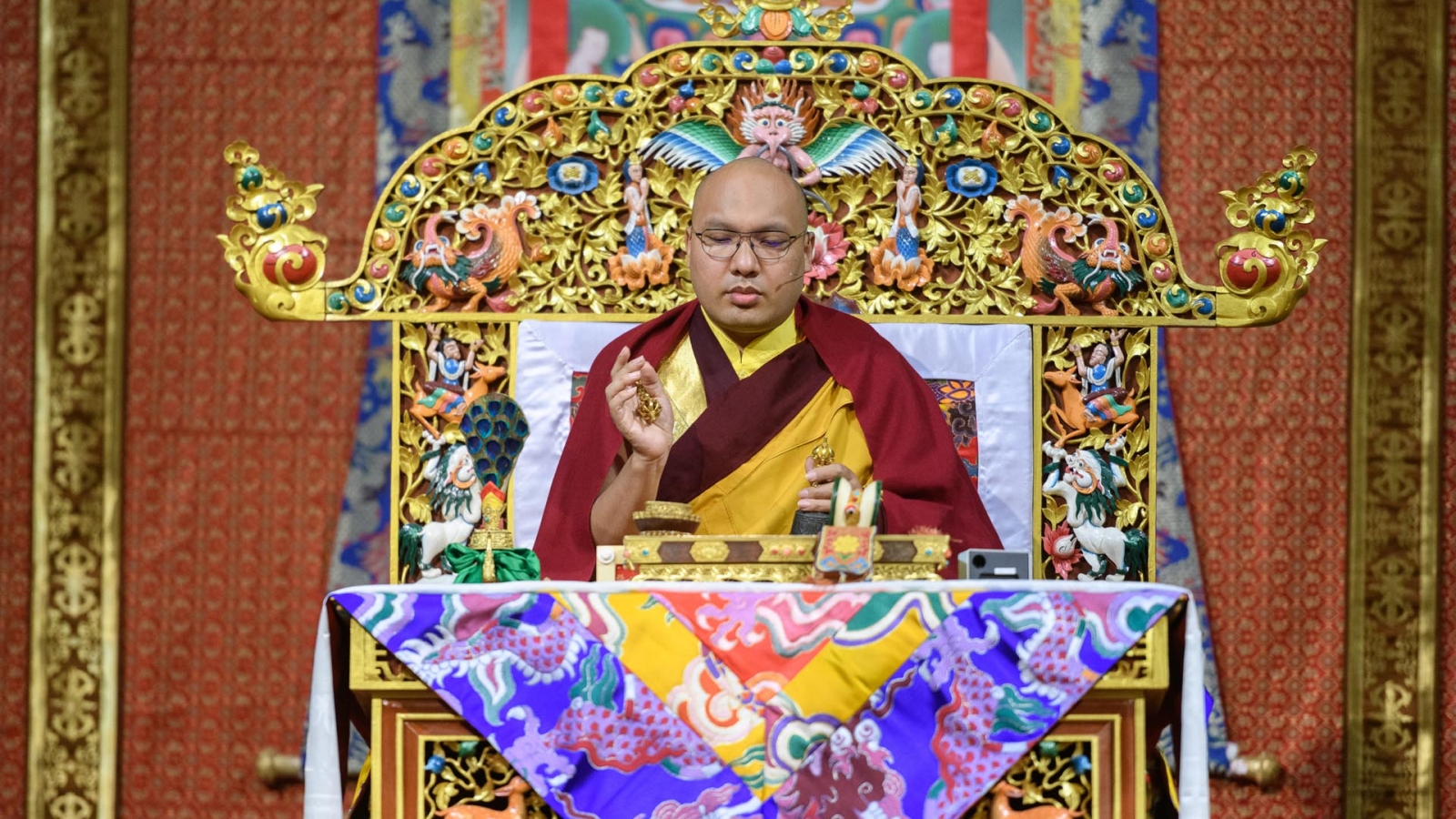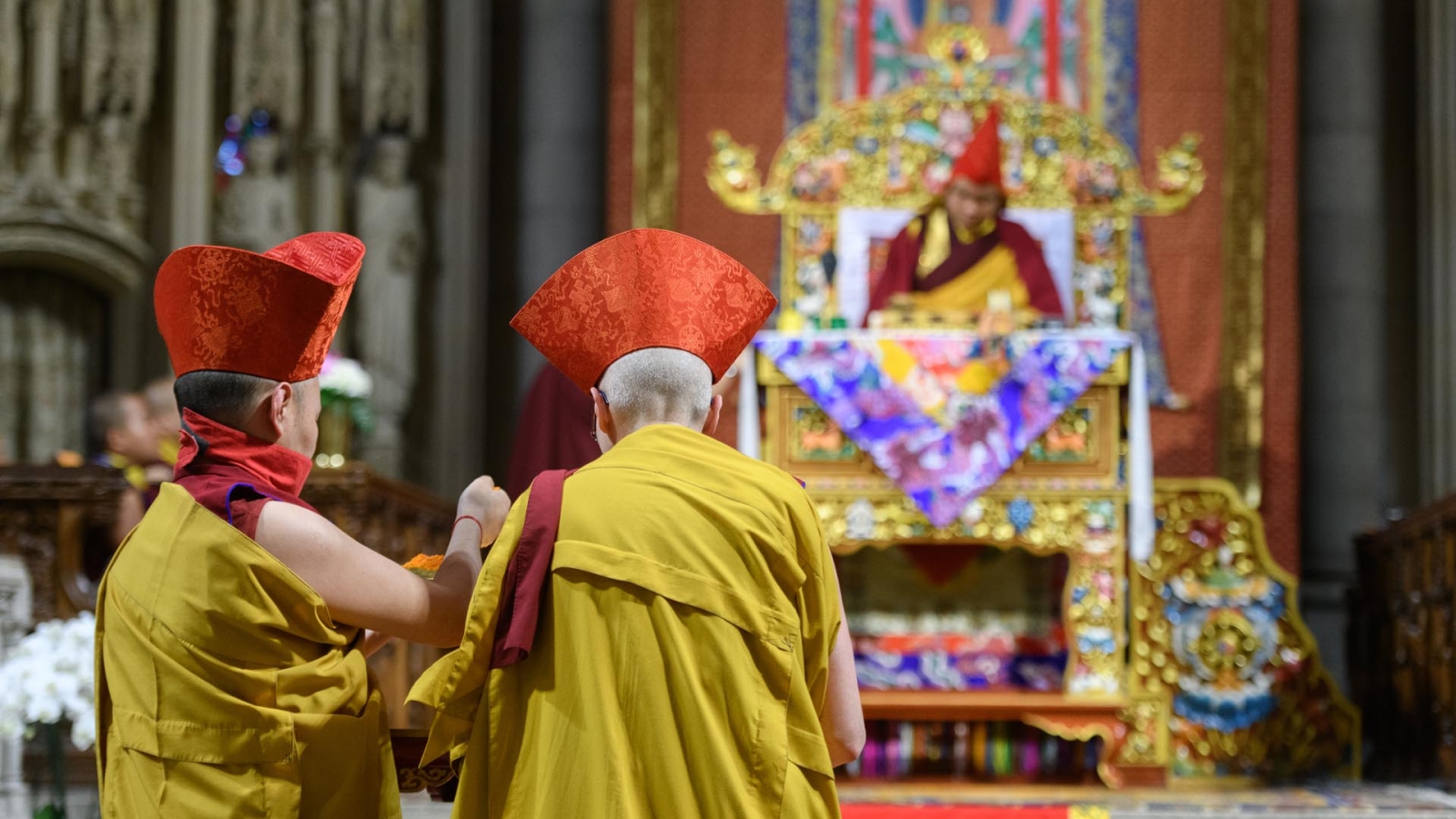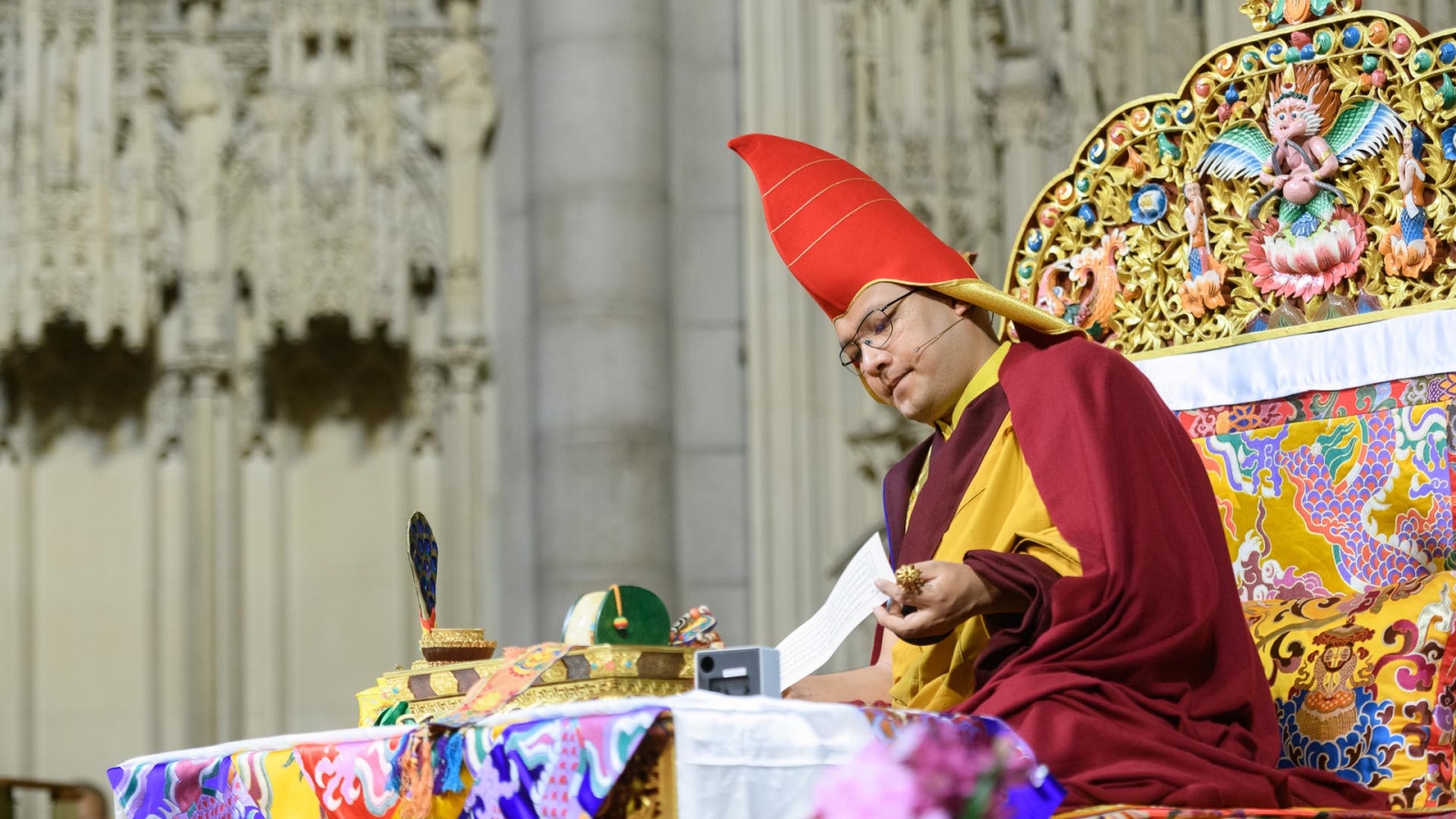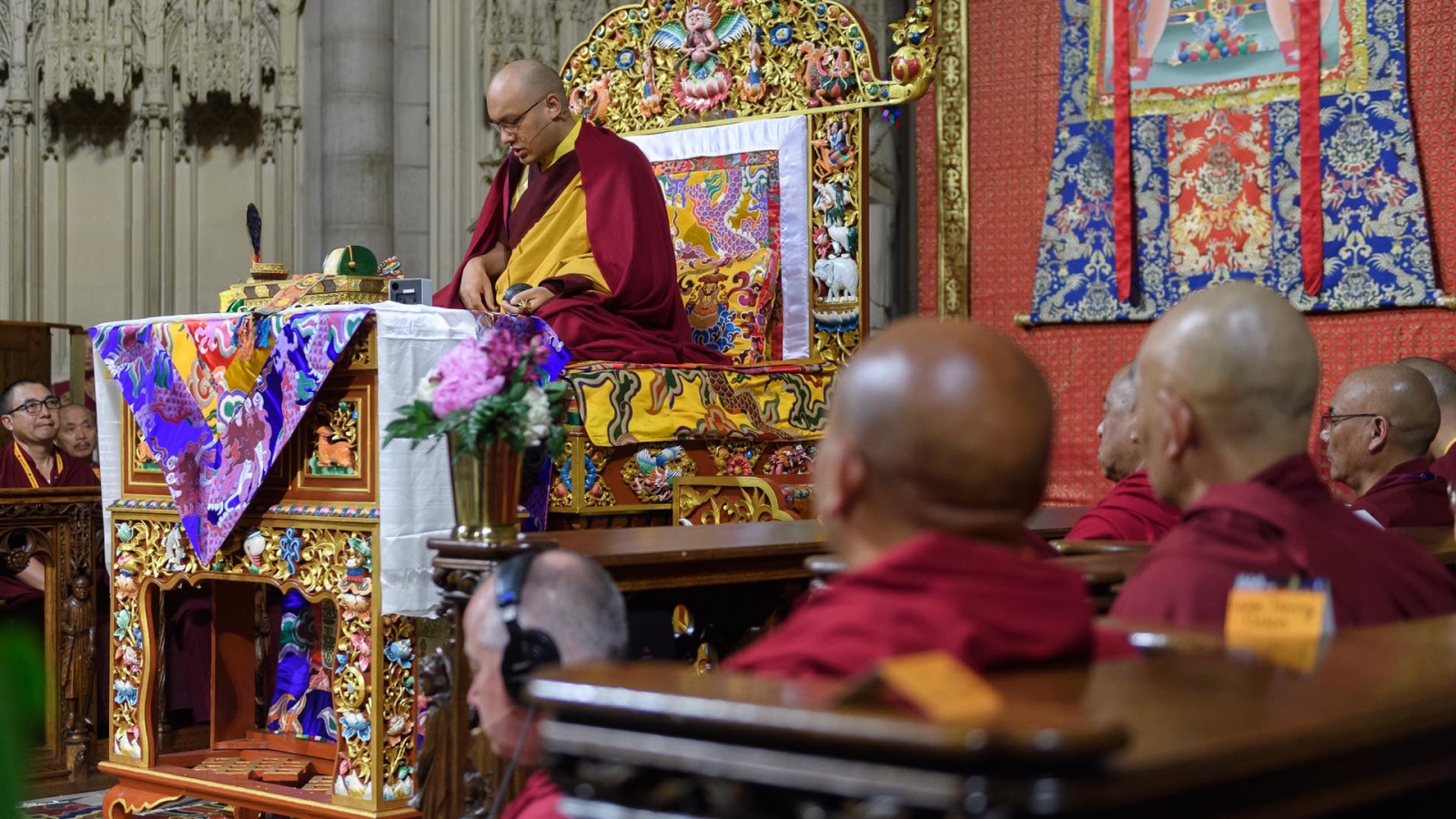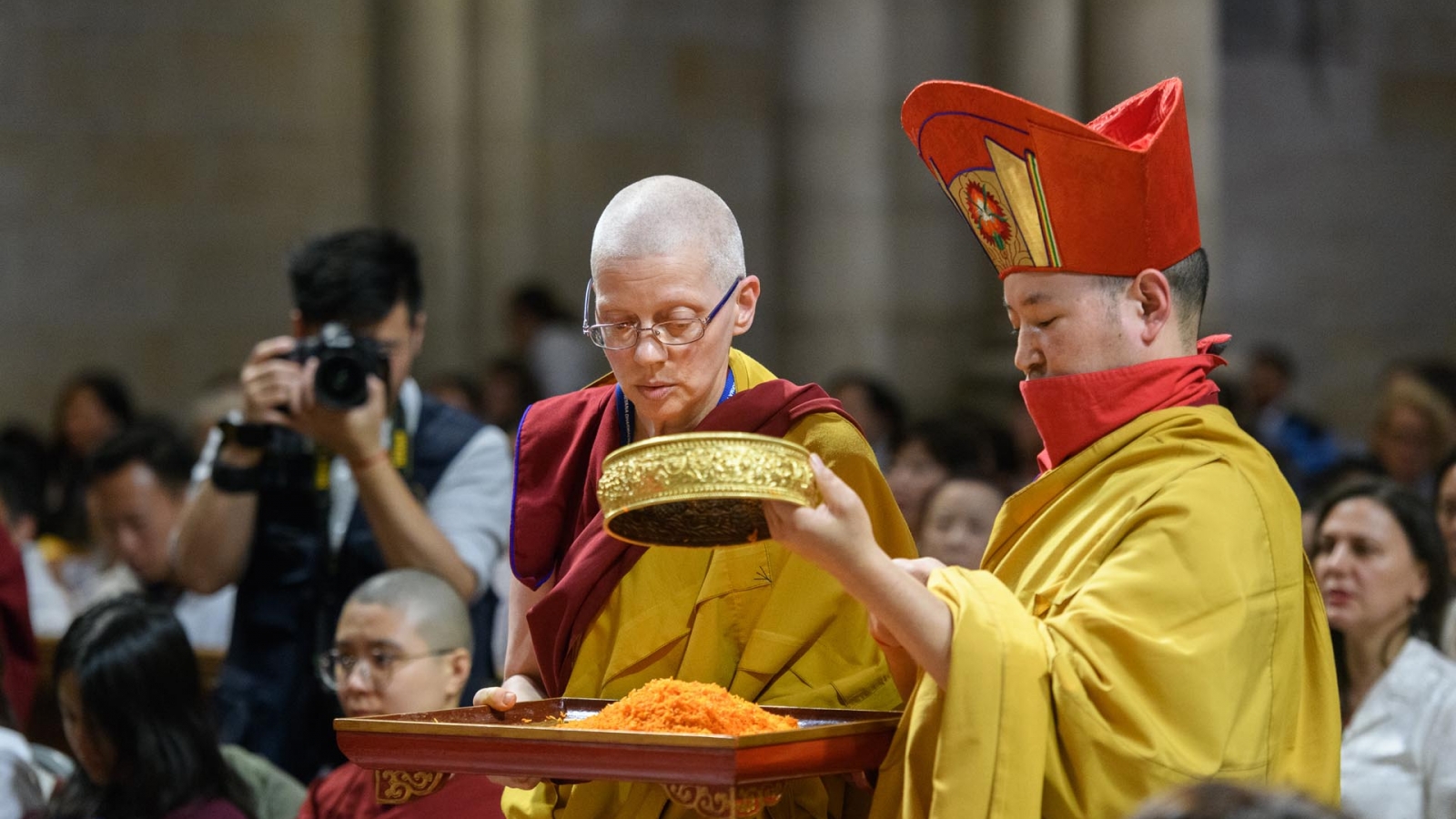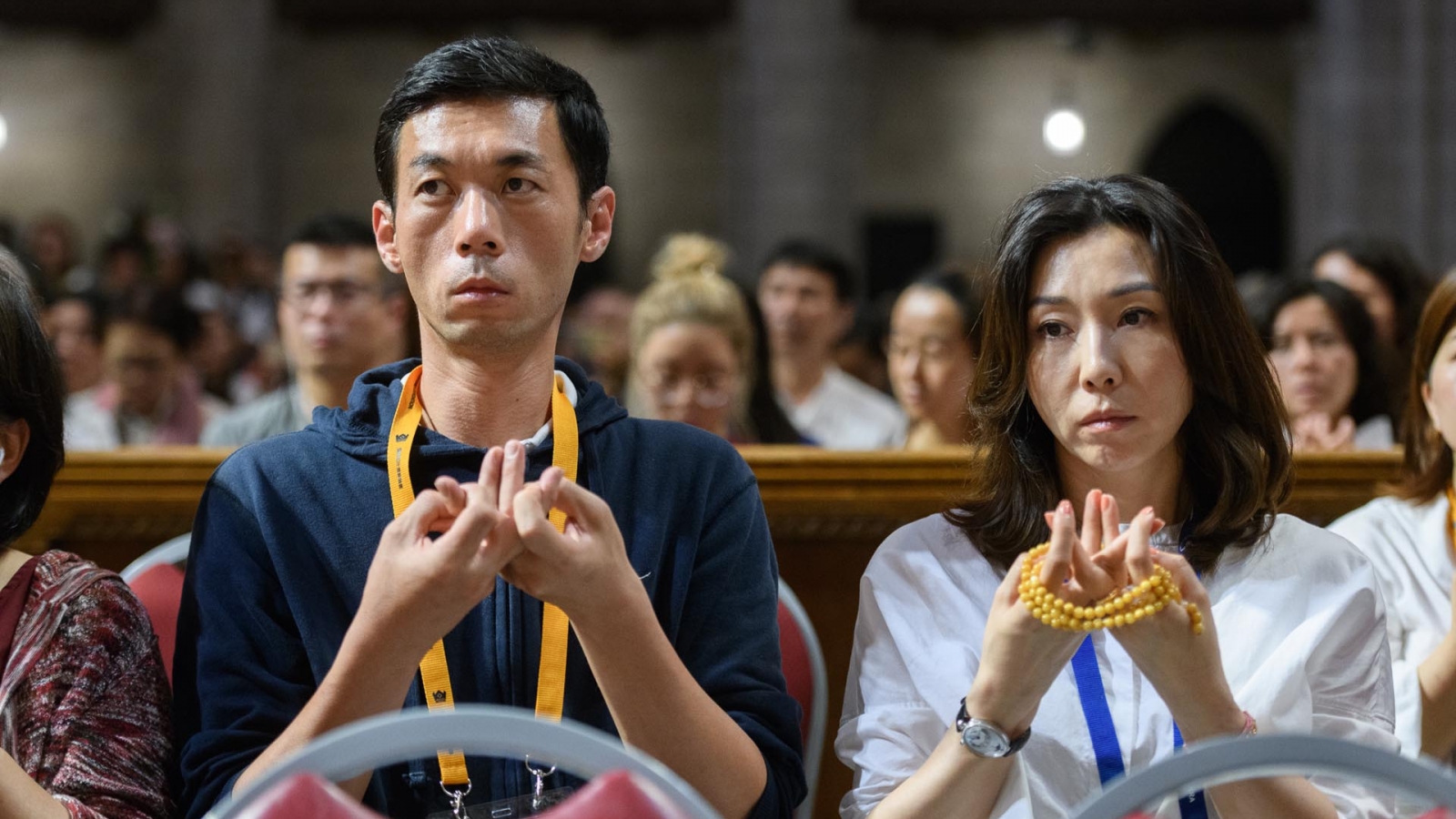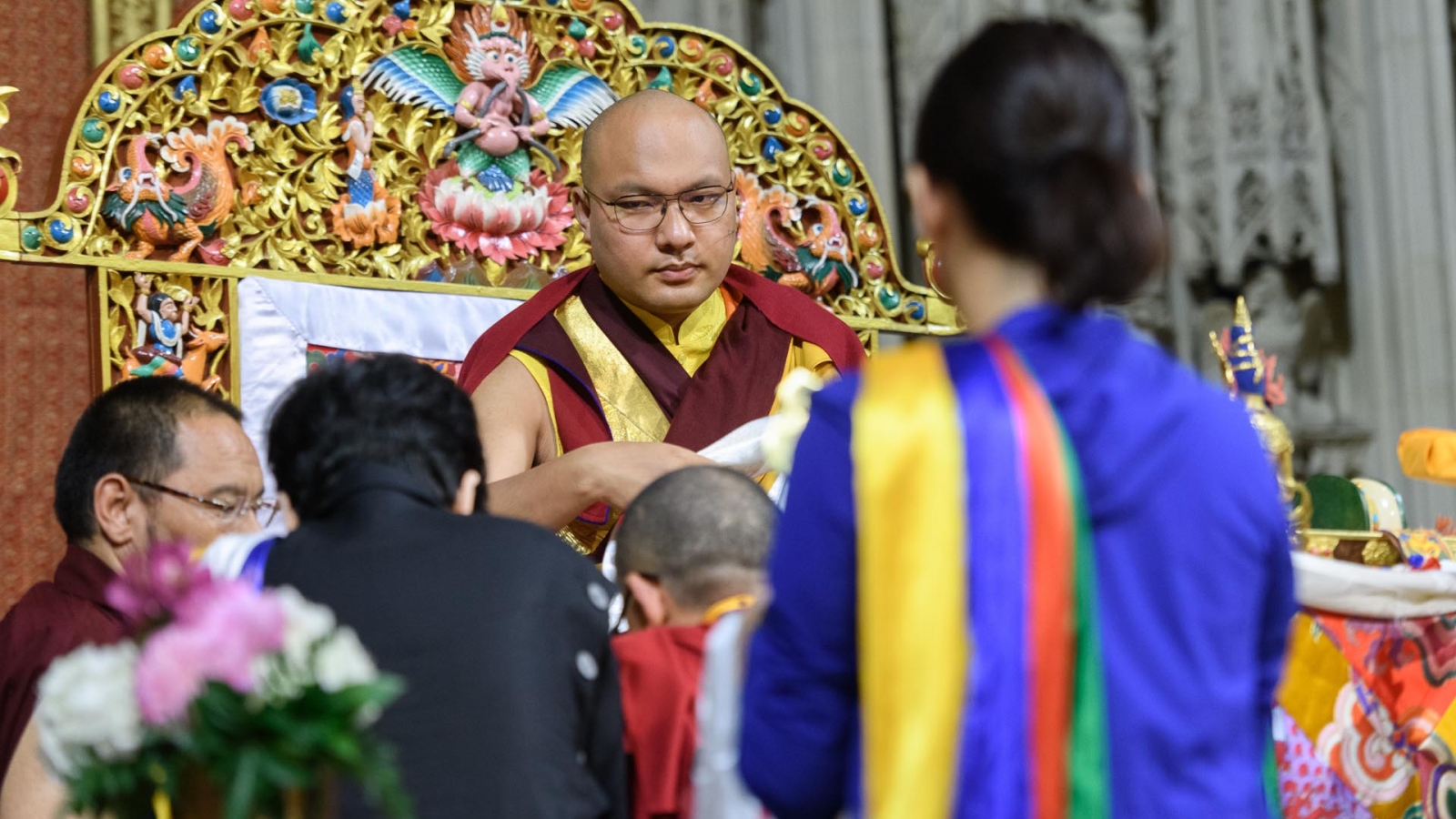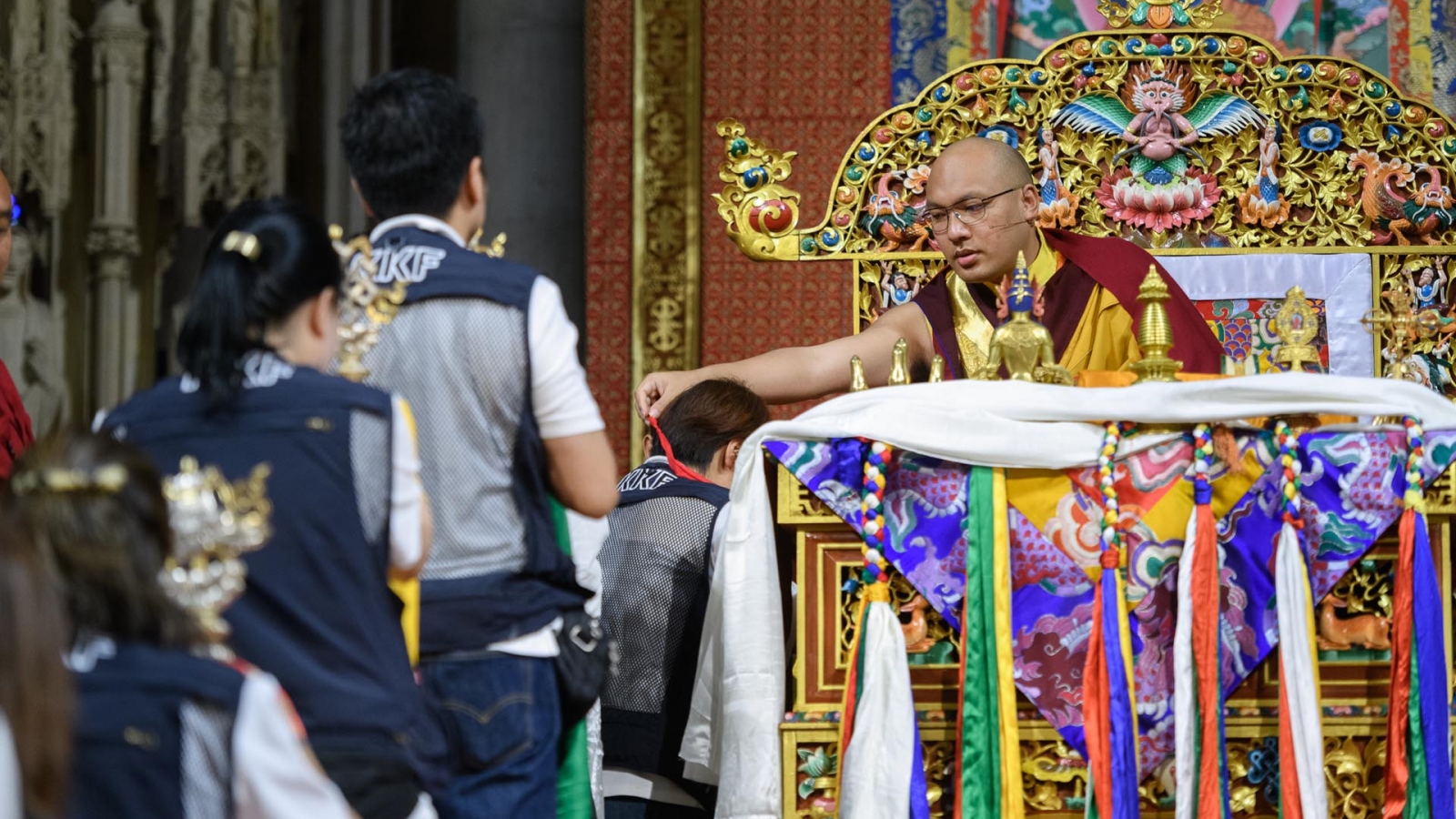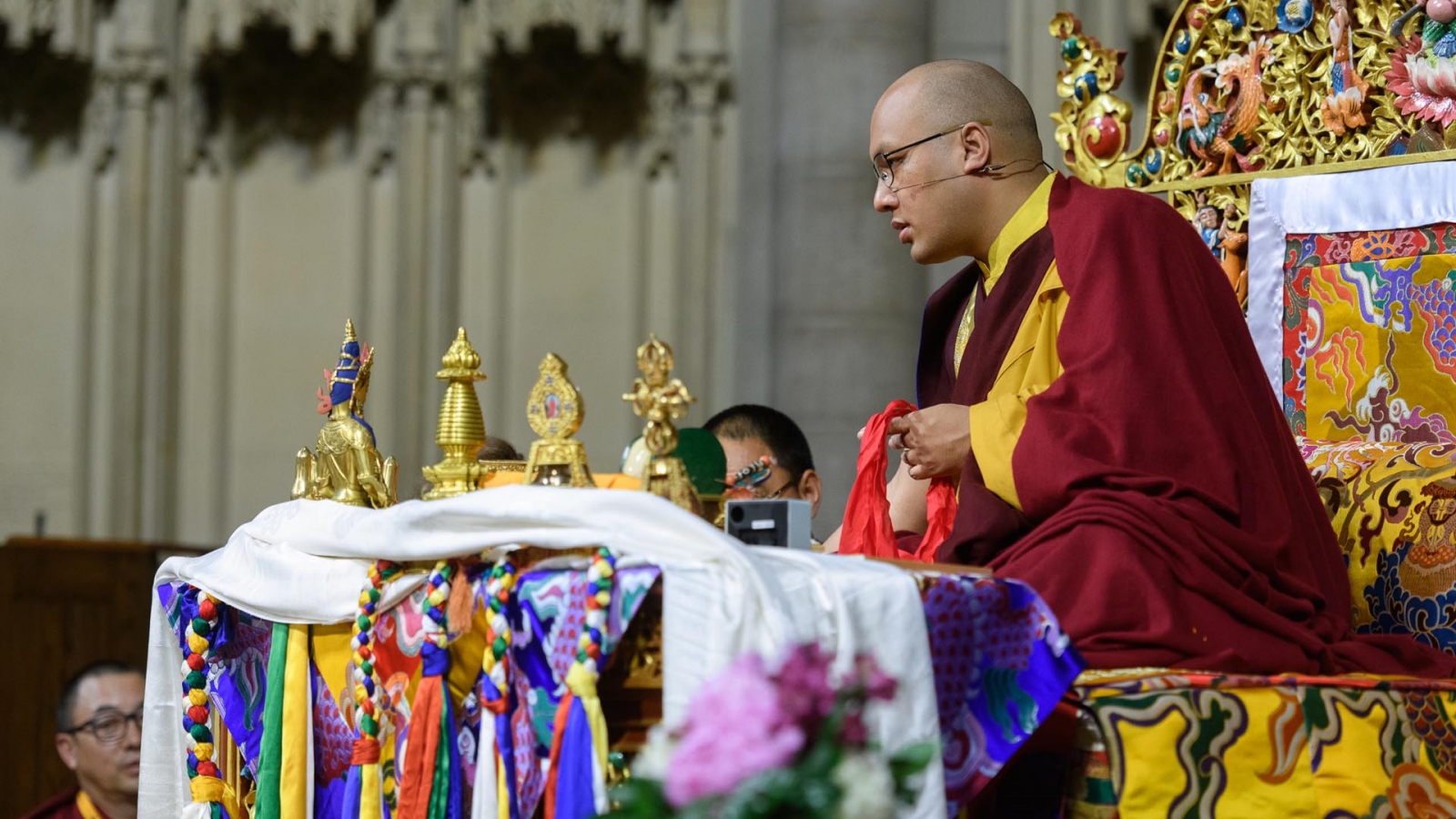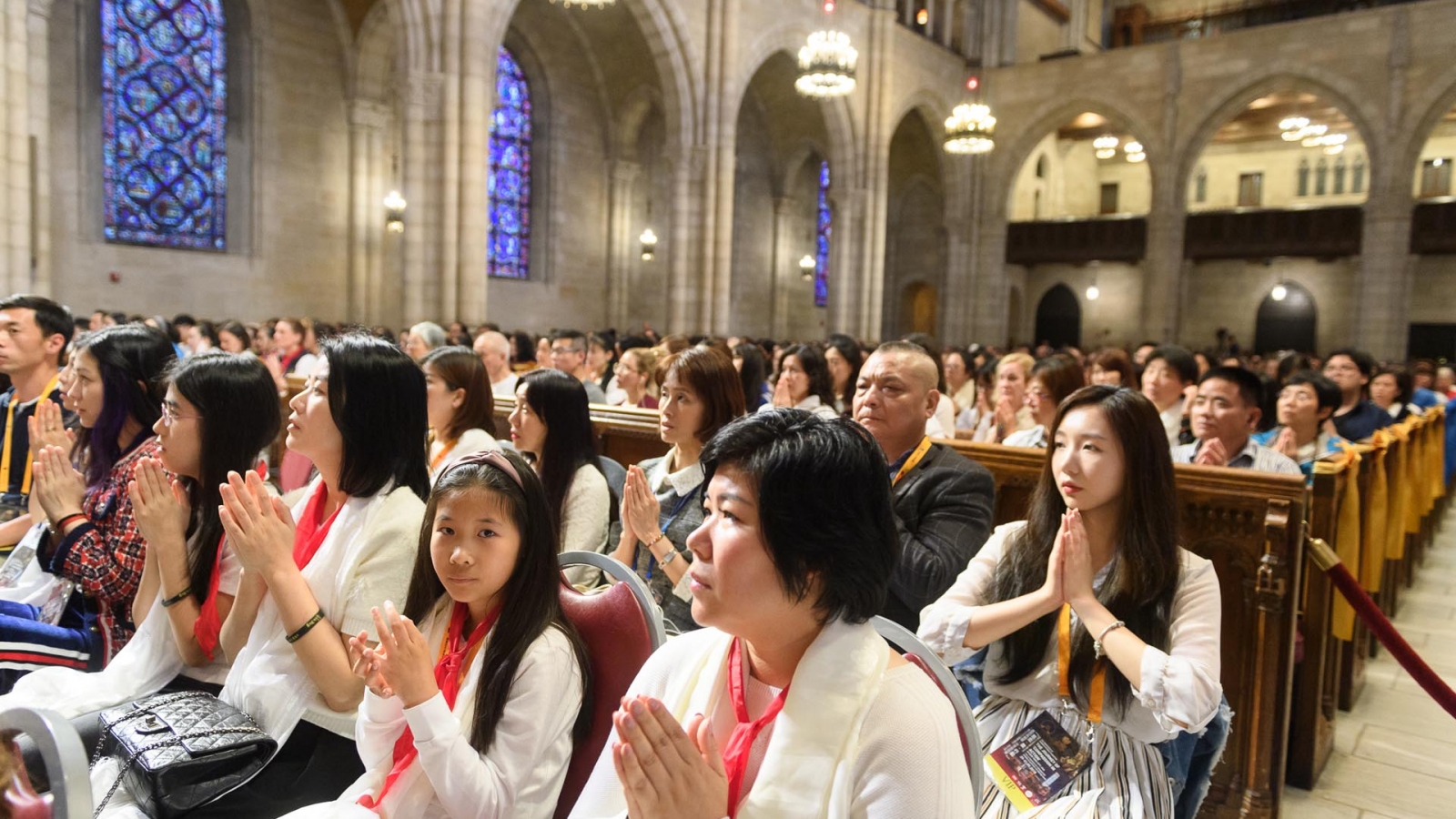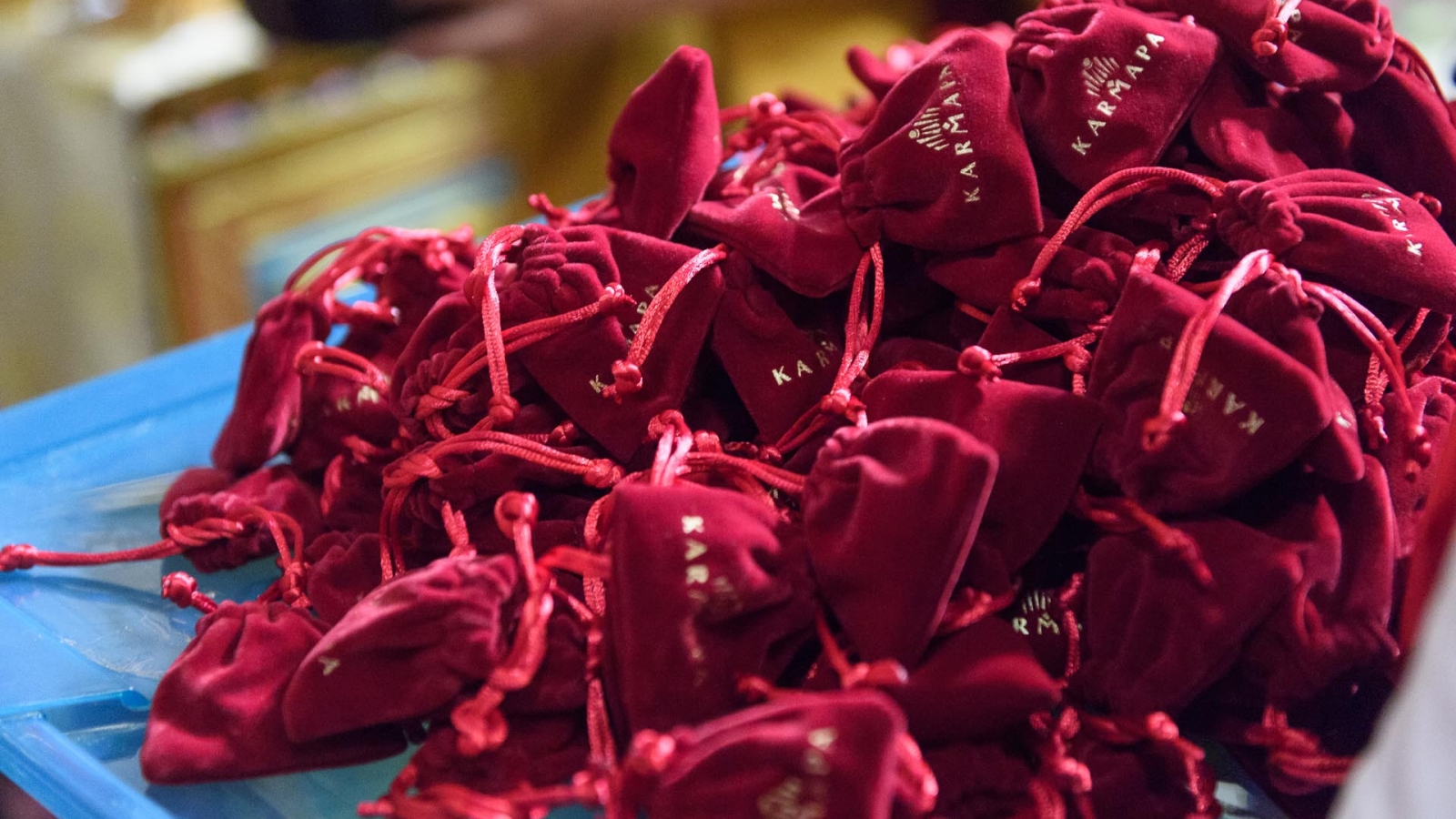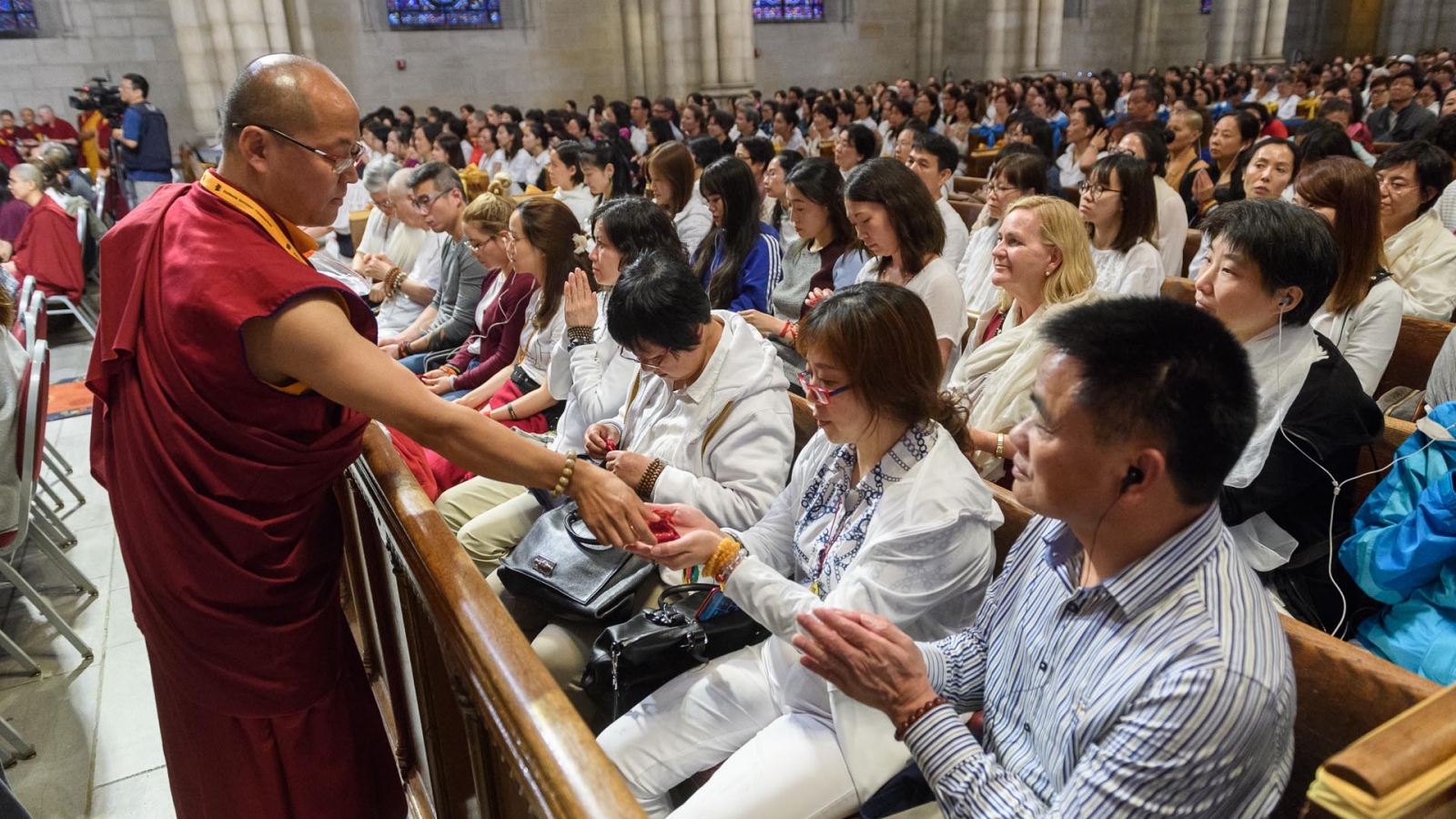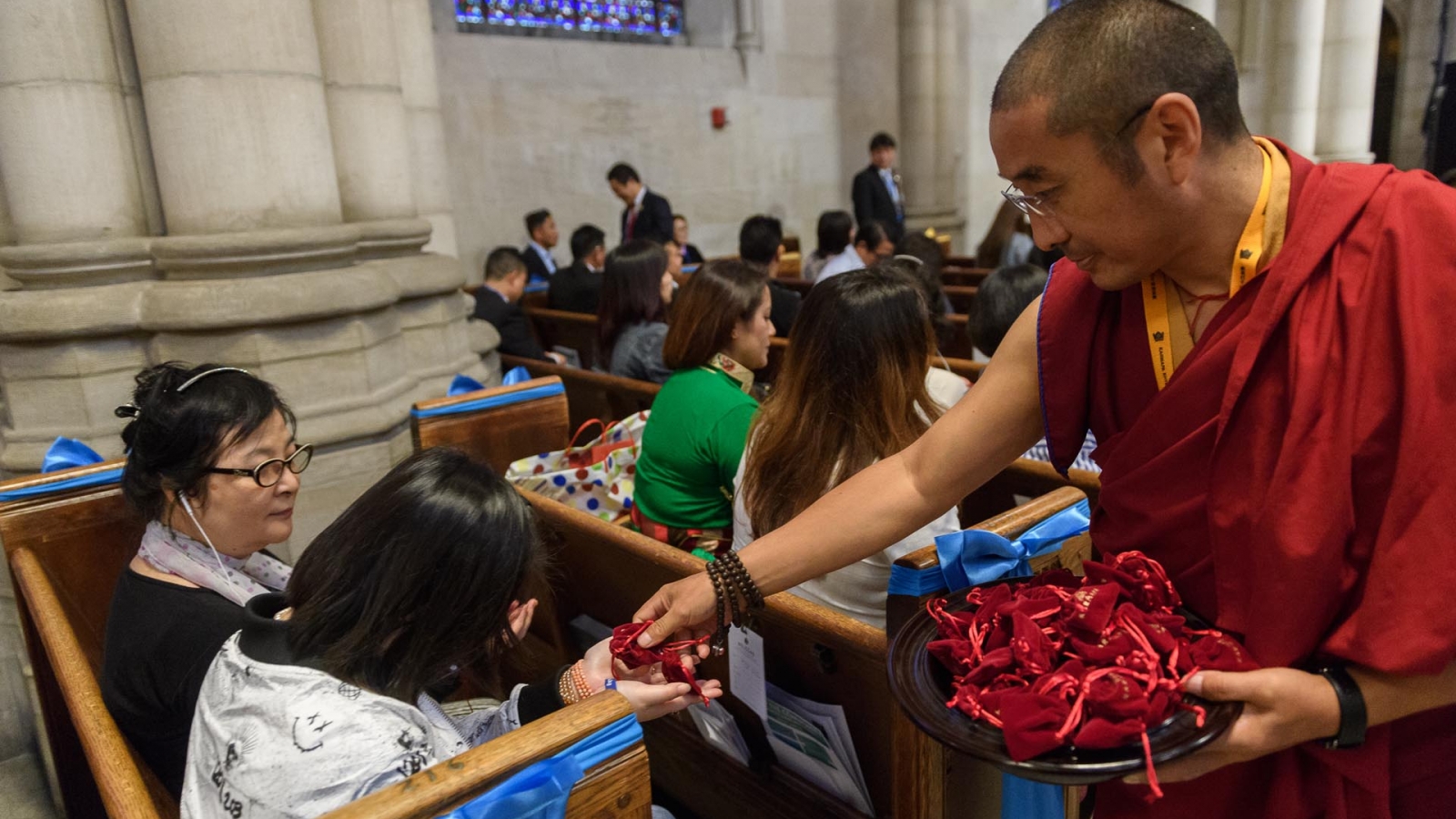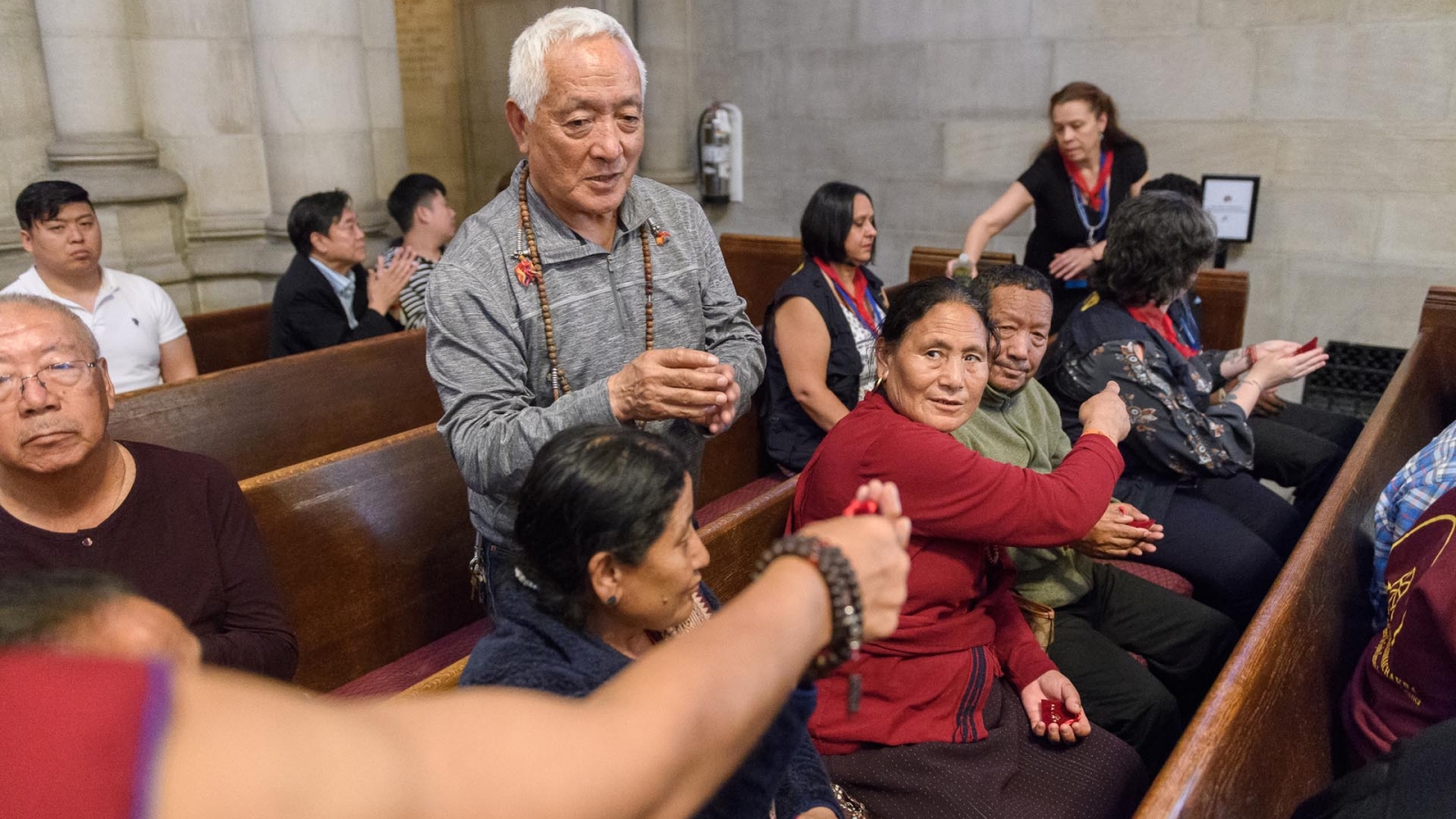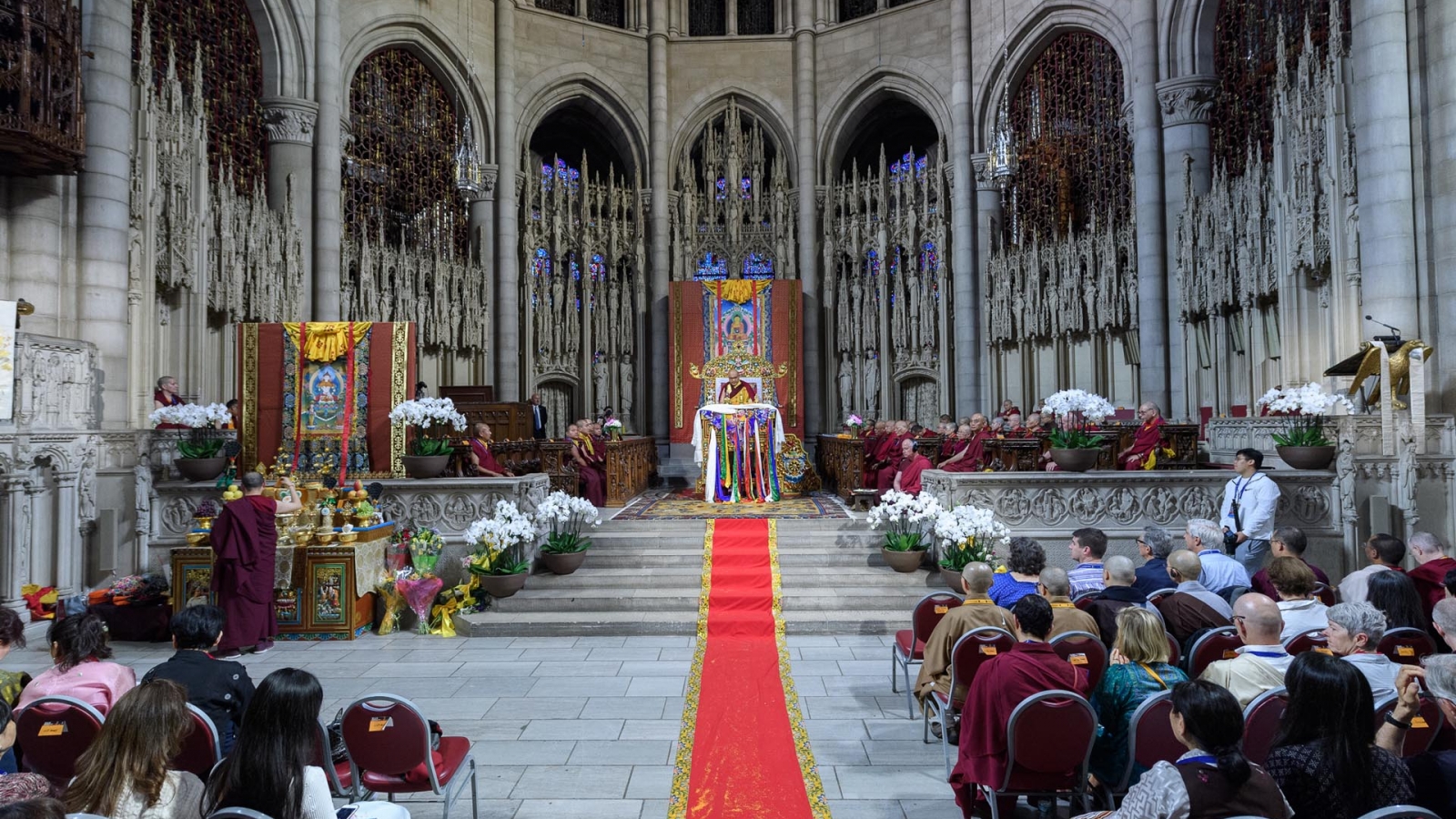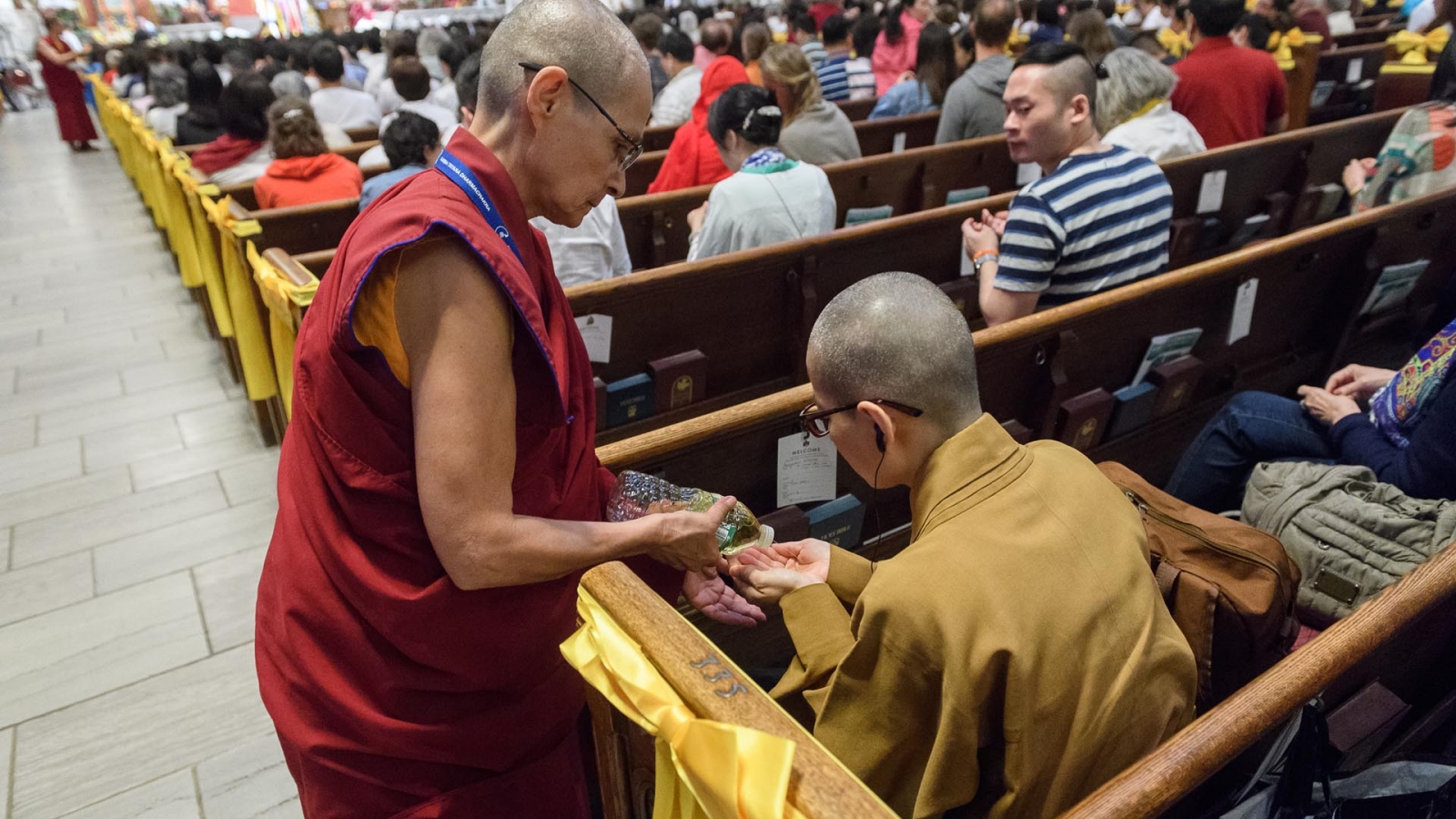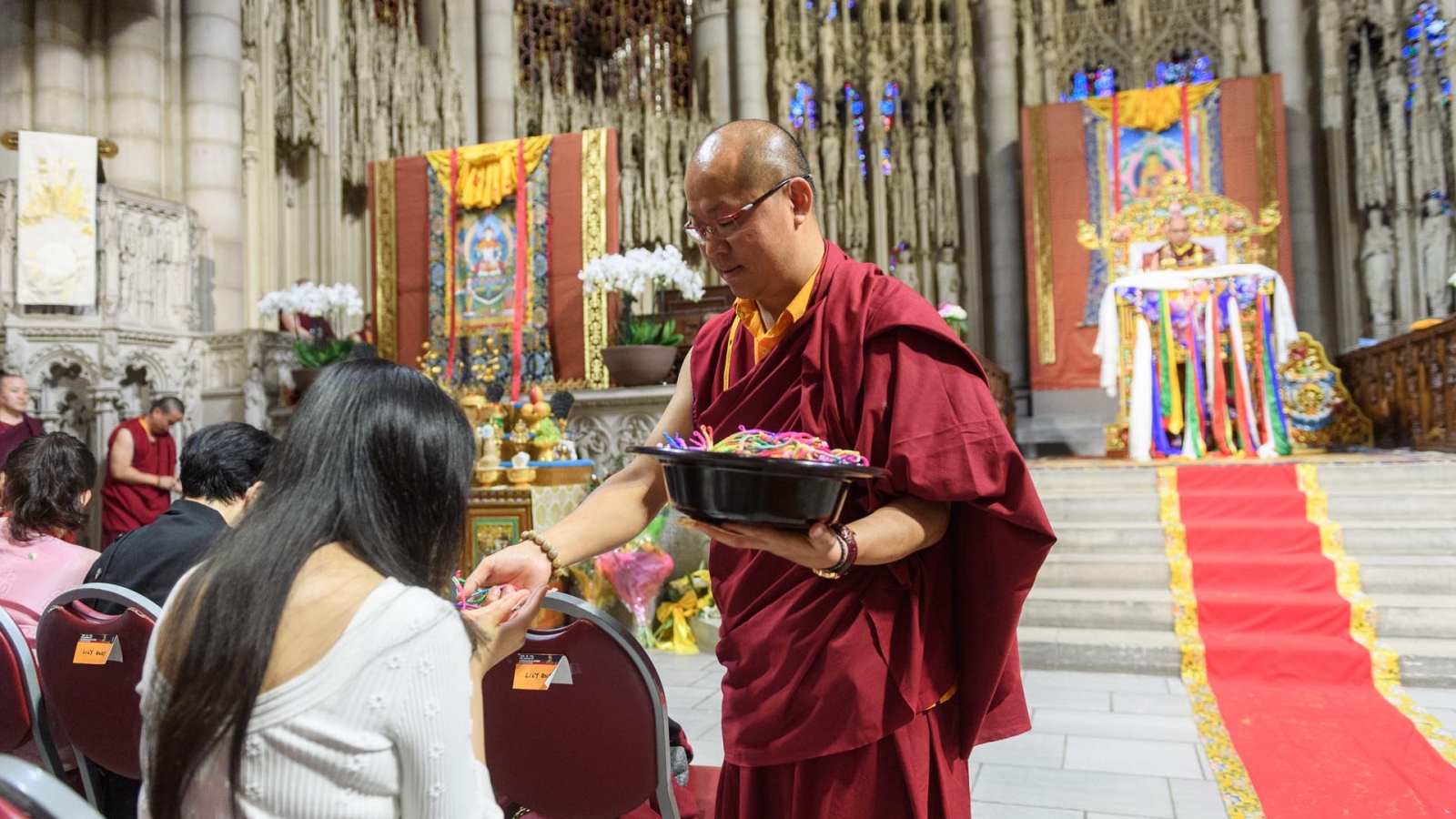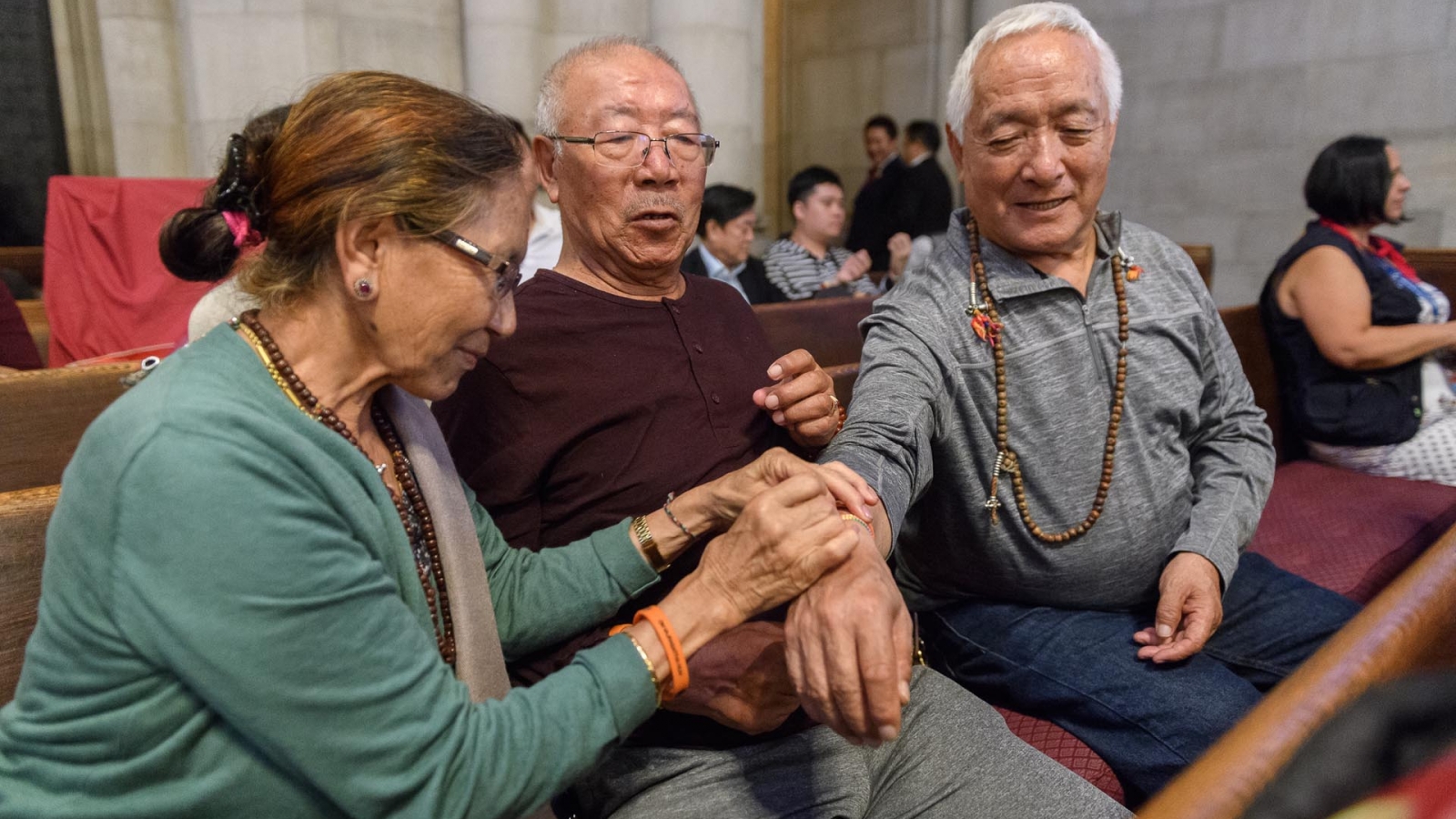Riverside Church, New York, New York — May 31, 2018
The Vajrasattva empowerment begin in the middle of Thursday afternoon as His Holiness the 17th Gyalwang Karmapa emerged from the rear of the church to an evocative chorus of melodic Karmapa Khyenno chanting. On the left just below the altar, a screen partitioned off a private space for the Karmapa to perform his ritual preparations in front of a Vajrasattva shrine, specially set up for this occasion.
The four-tiered shrine was beautifully adorned with seven offering bowls on the lowest shelf, golden sculptures representing the eight auspicious symbols on the next, and offerings of abundant fresh fruits with a Vajrasattva torma above them. A statue of the deity himself, Vajrasattva, resided on the top shelf, flanked by delicate arrangements of long-stemmed flowers coated in gold. On a marble ledge above the shrine were two long columns of smaller Vajrasattva statues with stunning arrangements of exquisite white orchids on either side. A large Vajrasattva thangka presided over all of this, set against a rust-colored silk background with golden vajra motifs running along the sides. The lovely shrine created a sacred vajrayana environment for the Vajrasatta empowerment to take place within the quiet magnificence of Riverside Church’s elegant chapel.
At the end of the previous day’s teaching the Karmapa spoke a few words about the approaching Vajrasattva empowerment, which added a bit of levity as well as some valuable background information. He said, “Somebody asked me, ‘Are you going to give a Vajrasattva empowerment?’ And I said, ‘I don’t know.’ So I asked the organizers, ‘Is it true that I’m supposed to give this Vajrasattva empowerment?’ And they said, ‘Yes!’ Then I realized I’ve become really old and had forgotten. Also, my childhood name is Apo Gaga, and that is why I am a little bit gaga.”
He continued amidst the laughter on a more serious note, “There are a lot of people who want to receive the Vajrasattva empowerment in order to do ngondro practice. There are two types of lineage traditions: one from yoga tantra and one from anuyoga tantra. Regarding the empowerment that I’m going to give, the tradition is from the three special deities of Marpa Lotsawa included within the Kagyu Ngakso. Usually in the Kagyu tradition, many rinpoches give the empowerment of Mingling Dorsem (Dorje Sempa), or the Vajrasattva practice from the Mindroling tradition. But I think that since people are practicing the Karma Kagyu ngondro, it is better to receive the Vajrasattva empowerment from the Marpa tradition. It is more appropriate and this is why I am going to give that empowerment tomorrow. And hopefully I won’t forget.”
Now, as the time for the empowerment had finally arrived, the Karmapa performed the preparations while the audience chanted Tara prayers. Then he took his throne in front of the Buddha Sakyamuni thangka. Youthful representatives from Bhutan, Tibet, China, Nepal and U.S. approached, bowed, and made offerings of flowers.
Then the Karmapa spoke, “This afternoon I shall present the empowerment and blessing of Vajrasattva in what is called the Single Hero or Solitary Father form, and this particular cycle of Vajrasattva practice and empowerment comes down to us from Lord Marpa.
“Many of you are involved in the ngondro (preliminary practices), which include the practice of Vajrasattva. Now strictly speaking, in order practice Vajrasattva within the preliminaries, you do not need to receive an empowerment because you are not imagining yourself as the deity, but imagining the deity above your head. Nevertheless, while it is okay to do the preliminaries without receiving the Vajrasattva empowerment, it is even better if you do receive one. So therefore, I feel it is a good idea to confer it.
“The practice of Vajrasattva is very important in the vajrayana. There are many different forms of ngondro, but they all include refuge, bodhichitta, and the practice of Vajrasattva. This is because refuge and bodhichitta are essential, and the Vajrasattva practice is particularly important, because in the vajrayana, we undertake samayas (commitments) that are not only numerous but very difficult to keep. The practice of Vajrasattva is a very effective way of restoring impaired samaya and reinforcing unimpaired samaya. It is also very important for the purification of wrongdoing in general, but especially violations of vows or commitments, and in particular impairments or violations of vajrayana samaya.”
His Holiness then bestowed the permission blessing or empowerment of Vajrasattva. Afterwards he said that several people had asked for the reading transmission of the four preliminary practices and also for the Four Session Guru Yoga of Mikyo Dorje, so he would confer these as well. He made a point of saying, “In my opinion it is best that you receive the empowerment of either Chakrasamvara or Vajrayogini before practicing the Four Session Guru Yoga. I don’t mean to say you cannot do it without having had one of those empowerments, but it is best to have had at least one of them.”
His Holiness then bestowed reading transmissions for the two Karma Kagyu preliminary practices, the long traditional version and a shorter version that he had composed himself.
After the transmissions, attendants passed around small velvet pouches containing elegant Buddha Akshobhya pendants, which were gifts from His Holiness. The Karmapa explained, “These images of the Buddha Akshobhya were originally intended to be distributed when I gave the Akshobhya empowerment at the request of the Karmapa Service Society last Sunday, but there were too many people there, and not enough of the medallions to go around. So it seems that through your merit, you are going to receive these Akshobhya medallions.”
Then he thanked the organizers saying, “The opportunity for us to share this time together was created by the Karmapa Khyenno Foundation of Hong Kong as well as various Hong Kong centers working together, and also by Karma Triyana Dharmachakra based here in New York state. I want to take this opportunity to thank the lamas, officers, members, and volunteers of all these groups for working so hard to make this tremendous event possible. I especially want to acknowledge the hard work of the many different Hong Kong centers, and all of you who have worked together in harmony. I not only want to thank you for this but to point out that it’s an excellent example of something that really we need to cultivate, because the Buddhadharma will not flourish unless the Sangha is in harmony. Therefore, I want to congratulate you. You’ve done extremely well in this regard and I sincerely hope and pray that you will continue to work together as harmoniously as you have been doing.”
The Karmapa then gave special thanks to the administration of Riverside Church, as well as all of the translators, media personnel, and security team. “I’d like to thank everyone, except myself,” he said, and a very special day ended on this humorous note.


